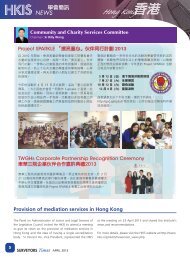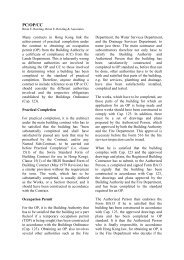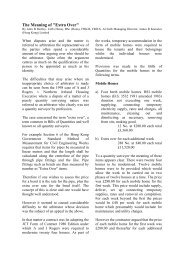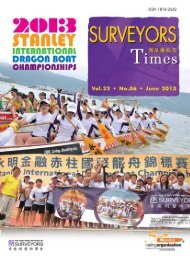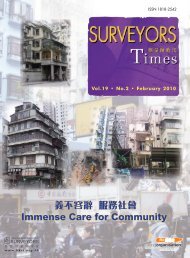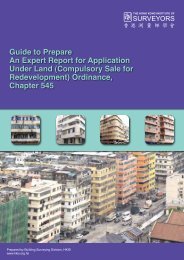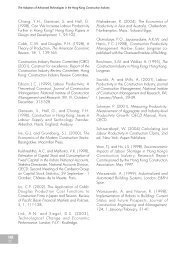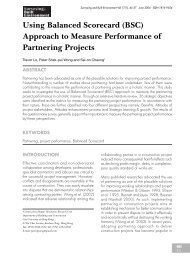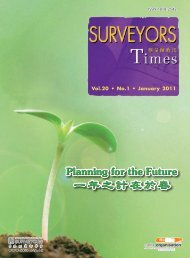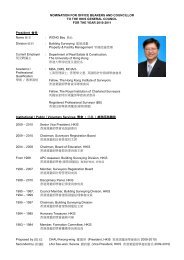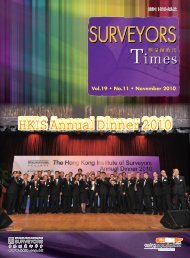Special issue to commemorate the 70th Anniversary of the Battle of ...
Special issue to commemorate the 70th Anniversary of the Battle of ...
Special issue to commemorate the 70th Anniversary of the Battle of ...
Create successful ePaper yourself
Turn your PDF publications into a flip-book with our unique Google optimized e-Paper software.
In memory <strong>of</strong> <strong>the</strong> <strong>70th</strong> anniversary <strong>of</strong> <strong>the</strong> <strong>Battle</strong> <strong>of</strong><br />
Hong Kong as an integral part <strong>of</strong> World War II, this<br />
special <strong>issue</strong> ga<strong>the</strong>rs nine pieces <strong>of</strong> scholarly and<br />
specialist work <strong>of</strong> different, but related, interest.<br />
Frank Lorne’s paper on war and peace <strong>of</strong>fers an<br />
economist’s perspective <strong>of</strong> <strong>the</strong> value <strong>of</strong> heritage, a<br />
tricky <strong>to</strong>pic, which has no satisfac<strong>to</strong>ry solutions. For<br />
fur<strong>the</strong>r reading on <strong>the</strong> valuation <strong>of</strong> heritage buildings<br />
using surveying techniques, see Yung (2007) and<br />
Zheng (2011).<br />
In a sense, World War II was <strong>the</strong> sequel <strong>to</strong> World War<br />
I, which was punctuated by <strong>the</strong> unsatisfac<strong>to</strong>ry Treaty<br />
<strong>of</strong> Versailles. Both China and Japan were Allies<br />
during <strong>the</strong> earlier war. Ho-yin Lee’s work about <strong>the</strong><br />
impression <strong>of</strong> Chinese eyes on Allied tanks in France<br />
has an interesting Hong Kong twist.<br />
Two key fights during <strong>the</strong> <strong>Battle</strong> <strong>of</strong> Hong Kong were<br />
<strong>the</strong> contests for <strong>the</strong> Shing Mun Redoubt along <strong>the</strong> Gin<br />
Drinker’s Line and at Wong Nai Chung Gap, both <strong>of</strong><br />
which featured pillboxes. Two papers address several<br />
tactical questions about <strong>the</strong>se contests, manifesting<br />
<strong>the</strong> indispensible value <strong>of</strong> surveying techniques and<br />
archive research in heritage study. A broader context<br />
<strong>of</strong> <strong>the</strong> Gin Drinker’s Line is provided by Bernard<br />
Lowry, <strong>the</strong> specific locations <strong>of</strong> <strong>the</strong> pillboxes and<br />
related structures <strong>of</strong> <strong>the</strong> Line are provided in a map in<br />
a technical note that follows, and a detailed account<br />
<strong>of</strong> a Gin Drinker’s Line pillbox (PB 419) before its<br />
demolition for highway work is documented by Y.K.<br />
Tan.<br />
SBE<br />
6<br />
<br />
Figure 3: Pillboxes 408, 418, and 421, Gin Drinker’s Line, Kwai Chung, 1950s<br />
Figure 3: Pillboxes 408, 418, and 421, Gin Drinker’s Line, Kwai Chung, 1950s <br />
The <strong>Battle</strong> <strong>of</strong> Hong Kong did not end <strong>the</strong> fighting, as<br />
<strong>the</strong> Japanese occupation forces were harassed by Allied<br />
air raids, <strong>the</strong> British Army Aid Group (BAAG), and<br />
Chinese<br />
<br />
guerrillas. Therefore, <strong>the</strong> Japanese carried<br />
out a lot <strong>of</strong> military construction in Hong Kong until<br />
<strong>the</strong> end <strong>of</strong> war on 15 August 1945. Some <strong>of</strong> <strong>the</strong>se<br />
structures survive <strong>to</strong> this day, and a technical note gives<br />
an account <strong>of</strong> several that were identified from aerial<br />
pho<strong>to</strong><br />
<br />
interpretation backed, where possible, by field<br />
surveys.<br />
<br />
How does an “expatriate” look at war relics? The<br />
memoir <strong>of</strong> Dave Manning, who grew up in our<br />
multicultural and open society, has given us a glance <strong>of</strong><br />
one such view.<br />
<br />
To a person who regards Hong Kong as his/her home,<br />
<br />
4<br />
Pho<strong>to</strong> courtesy <strong>of</strong> Mr. Y.K. Tan.<br />
<br />
<br />
a better knowledge <strong>of</strong> <strong>the</strong> signs and symbols found<br />
in building heritage means a fuller picture <strong>of</strong> reality.<br />
For those familiar with English place names inscribed<br />
on <strong>the</strong> cement tunnels and bunkers in <strong>the</strong> Shing Mun<br />
Redoubt, <strong>the</strong> scene <strong>of</strong> a street in London, as shown in<br />
<strong>the</strong> pho<strong>to</strong> below (Figure 4) 4 , taken during Summer<br />
2008, should ring a bell.<br />
The putting <strong>to</strong>ge<strong>the</strong>r <strong>of</strong> <strong>the</strong> papers and notes in this<br />
special <strong>issue</strong> would have been impossible but for <strong>the</strong><br />
helpful advice <strong>of</strong> referees including Mr. Chohong Choi,<br />
Mr. Bishop W.K. Chung, Dr. Peter Cunich, Dr. Stephen<br />
Davies, Dr. Bruce Harvey, and Mr. Bernard Lowry.<br />
Pr<strong>of</strong>essor Lawrence WC Lai<br />
24 Oc<strong>to</strong>ber 2011<br />



